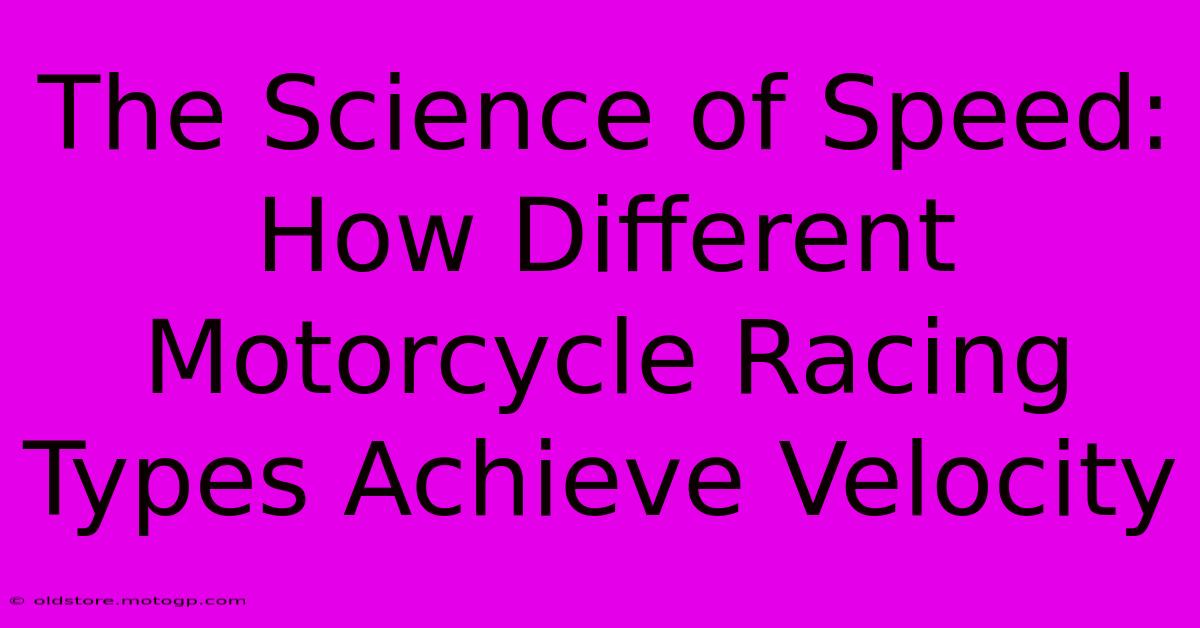The Science Of Speed: How Different Motorcycle Racing Types Achieve Velocity

Table of Contents
The Science of Speed: How Different Motorcycle Racing Types Achieve Velocity
Motorcycle racing, a thrilling spectacle of speed and skill, encompasses diverse disciplines, each with its unique approach to maximizing velocity. Understanding the science behind these variations reveals fascinating insights into engineering, rider technique, and the pursuit of ultimate speed. This article delves into the key factors that contribute to the breathtaking speeds achieved in different motorcycle racing categories.
The Physics of Speed: A Foundation for All Racing
Before diving into specific racing types, it's crucial to grasp the fundamental physics governing speed. Newton's second law (F=ma) dictates that acceleration is directly proportional to the net force acting on an object and inversely proportional to its mass. In motorcycle racing, this translates to:
- Maximize Force: This involves optimizing engine power, aerodynamic design, and tire grip.
- Minimize Mass: Lightweight materials and components are crucial for maximizing acceleration.
These fundamental principles are applied differently across various racing categories.
Road Racing: Aerodynamics and High-Performance Engines
Road racing, encompassing disciplines like MotoGP, Superbike, and World SuperSport, prioritizes high speeds achieved through a combination of factors:
Powerful Engines: The Heart of Speed
MotoGP bikes boast incredibly powerful engines, often exceeding 250 horsepower. This raw power is harnessed through sophisticated gearboxes and sophisticated engine management systems for optimal acceleration and top speed.
Aerodynamics: Cutting Through the Air
Aerodynamics play a vital role in road racing. Fairings, winglets, and other aerodynamic components are meticulously designed to minimize drag and maximize downforce, keeping the bike stable at high speeds while improving cornering abilities. The sleek design is crucial for cutting through the air resistance efficiently.
Tire Technology and Grip: The Connection to the Road
Specialized racing tires provide exceptional grip, allowing for high cornering speeds and efficient power transfer to the asphalt. The tire compounds and construction are optimized for specific track conditions and racing styles.
Flat Track Racing: Power Slides and Controlled Chaos
Flat track racing, with its oval dirt tracks, showcases a different approach to speed. Here, the focus shifts from outright top speed to controlled drifts and skillful power slides:
Engine Power and Torque: Crucial for Drifting
While not as high in horsepower as road racing machines, flat track bikes prioritize torque for maintaining momentum through turns. The powerful engines enable riders to initiate and control slides with precision.
Tire Design: Grip on Loose Surfaces
Specialized flat track tires, often with knobby treads, are designed for maximum grip on loose dirt surfaces. These tires provide the traction needed to execute power slides and maintain control at high speeds while cornering.
Rider Skill: The Defining Factor
Rider skill is paramount in flat track racing. The ability to control a motorcycle while drifting at high speeds separates the champions from the rest.
Drag Racing: Pure Acceleration
Drag racing is all about pure acceleration over a short distance. Here, maximizing initial acceleration is the ultimate goal.
Specialized Engines: Unleashing Maximum Horsepower
Drag racing motorcycles employ highly tuned engines that prioritize explosive power delivery. These engines prioritize maximizing horsepower and torque, and the bikes themselves are designed and built solely for rapid acceleration.
Lightweight Construction: Minimizing Inertia
Minimal weight is critical to achieving rapid acceleration in drag racing. Every component is carefully selected for its lightweight properties.
Aerodynamics: Minimizing Drag at High Speeds
While drag is less significant over short distances, streamlined designs still help in achieving optimal acceleration. The goal is to avoid any excess resistance as the motorcycle accelerates.
Conclusion: A Spectrum of Speed
The science of speed in motorcycle racing reveals a fascinating array of engineering solutions and riding techniques tailored to the specific demands of each discipline. From the aerodynamic refinements of MotoGP to the controlled chaos of flat track racing, the pursuit of velocity remains the driving force, pushing the boundaries of technology and human skill. Each racing category presents a unique challenge, showcasing the incredible diversity and complexity of this exhilarating sport.

Thank you for visiting our website wich cover about The Science Of Speed: How Different Motorcycle Racing Types Achieve Velocity. We hope the information provided has been useful to you. Feel free to contact us if you have any questions or need further assistance. See you next time and dont miss to bookmark.
Featured Posts
-
F1 Qualifying Today Every Hundredth Counts
Feb 22, 2025
-
The Insiders Guide To Cota Formula 1 Austin Map Revealed
Feb 22, 2025
-
Cota Parking Avoid The Frustration Park In Lot R
Feb 22, 2025
-
The Best Motorcyclist Of All Time A Name That Will Live On
Feb 22, 2025
-
The Best Motorcyclist Pushing The Boundaries Of Speed
Feb 22, 2025
